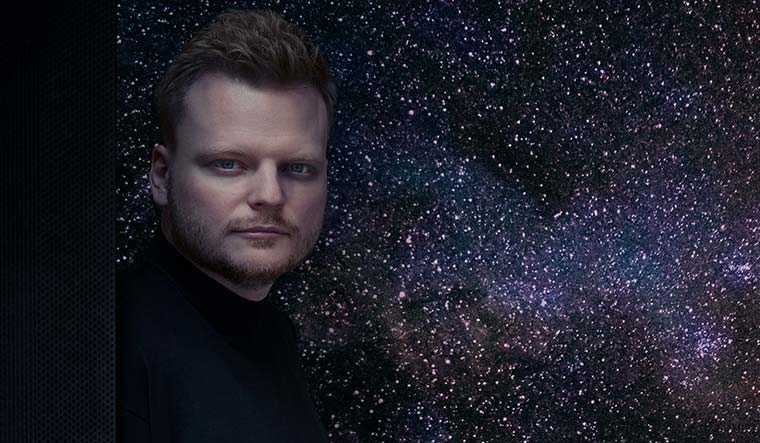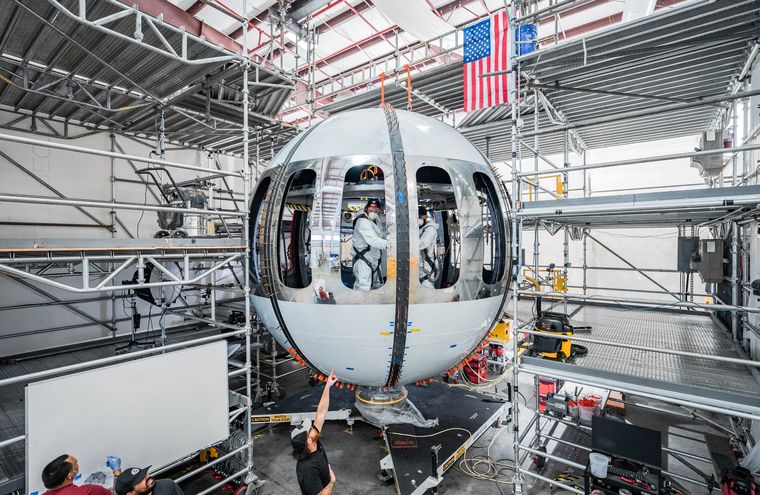Consider this for a meal: rarefied albino caviar, golden in colour and result of uncommon mutations―eggs of the sterlet, a small species of sturgeon (fish) from Eurasia, native to large rivers that flow into the Black Sea, supple and velvety, plated with white asparagus and pastry bread. Another course has a mousse of lamb brains and foie gras served in a bleached lamb skull, garnished with ants and roasted mealworms with a drink containing bioluminescence extracted from jellyfish, glowing beautifully in dim lights. There is also a human brain on the table―the cavity of a realistic, life-size model of a man’s head―a theatrical spectacle for an immersive experience. These mind-blowing mouthfuls of food are central to Alchemist, a two Michelin-starred restaurant in Copenhagen. Helming this creative innovation is chef and co-owner Rasmus Munk, known for making Alchemist a holistic cuisine restaurant that normally charges upwards of Rs50,000 a head and offers 45-plus courses in six-hour-long tasting menus.
At 33, Munk has already aced his recipe for running a restaurant that is famous as much for its imaginative dishes as for its “politically charged” messages served on the side. At Alchemist, both visual appeal and earthy tastes are equally significant and neither can overshadow the other. Take, for example, the red cherry glazed lamb brain, poached and sliced surgically in front of the diner, or the pigeon breast served dangling from its feathered head. Even its location seems to be carefully picked―a relatively remote part of Copenhagen known for its industrial buildings and an old shipyard. Perfect plot to forge fantasy and food! Even the “two-tonne-heavy bronze” doors have a dramatic air about them, with “decorations reminiscent of Narnia or Middle-Earth”, wrote the World’s 50 Best Restaurants that adjudged Alchemist as the eighth best restaurant in the world this year. Inside, the dining experience takes place under a planetarium dome with graphic sceneries that change with the dishes served.
“The recipe for running a successful restaurant, I think, is having the right people working with and for you,” Munk tells THE WEEK over Zoom from Copenhagen. “A good team creates the content. The content is what gets the attention for both the food and the design. What makes Alchemist different from other restaurants is our approach to storytelling and creating an experience. We are looking beyond the plate, the design on the cutlery. The mouthfeelings, the textures, the sound, the activism―you try to convey through your dishes. In that way, it is more of an experience. I think I treat Alchemist more as an art form than a restaurant and that’s what made the difference.”
So, what’s next on his list? To cater to diners at the edge of space, at 1,00,000ft above sea level, and watch the sunrise over the earth’s curvature. Sounds too far-fetched? Well, the rough model of what the dining room would look like is all ready! Towards the end of 2025, six select guests―wealthy, discerning and adventurous―will embark on a six-hour journey to the stratosphere aboard Space Perspective’s Spaceship Neptune off the coast of Florida. The spacecraft in question is a pressurised capsule that will be lifted gently by a SpaceBalloon, and not a rocket. Each of the guests will wear made-to-measure designer outfit by French fashion house Ogier. And, Munk will serve them “an experience like no other”―all for $4,95,000 (Rs3.84 crore) per person.
 ‘Memories of Sakura’, a dish created by Munk’s Alchemist RD-lab with Maggie Coblentz of MIT | Jon Angelo
‘Memories of Sakura’, a dish created by Munk’s Alchemist RD-lab with Maggie Coblentz of MIT | Jon Angelo
“What now seems like once-in-a-lifetime opportunity could become a normal, regular feature years down the line,” says Munk. “Once we return to earth, this journey will become a historical precedent recorded in scientific journals on the what and how aspects of taking fine-dining into outer space. It will be a showcase for the gastronomical industry. We are at the brainstorming stage at the moment; they are still test-flying the capsule.”
So, how did this seemingly novel and wildly ambitious idea come into being? “We were approached by this US-based company, Space VIP, a luxury space travel group,” says Munk, who measures his words and uses a range of expressions to convey his thoughts. “The CEO of the company, Roman [Chiporukha], was talking a little bit about the food and doing a dinner in space and we both were quite excited.” What brought the chef and the CEO together more than food was storytelling. “Food is more like a medium that we use to cultivate our stories,” says the molecular gastronomist. “We are very much driven by the storytelling. And I think that was probably what really enhanced this collaboration because he is (Chiporukha) kind of the same. So we want to have some impact with this project and talk about issues that matter and not just serve a jellyfish dish in space. The publicity that goes into this project is quite enormous. Also in the next two years, research is going to be amazing because we actually have the financials to do it. This project is carbon neutral. So the flight doesn’t require motors or anything, which is exactly the way we want it to be.”
At the moment, Munk is in talks with different corporate partners to collaborate on technology, design and new ways of growing ingredients that can be taken to space. He is already collaborating with Massachusetts Institute of Technology researchers on food for space travel. “We are developing the menu and the whole concept around it, like plates and designs, the way you will get your tickets, [how we will] transport guests from wherever they are in the world to the location, the experience when they come down to earth again and land in the sea, the way we pick people up in boats and provide them a novel boating experience. So all these experiences that are part of this expedition are very interesting.”
And, all you need is money (lots of it, we agree) to be part of this novel experience. No fitness certificates will be needed, except from those with heart conditions. “The only thing is you shouldn’t gain 100kg, so as to avoid any problems up there,” says Munk. “But it is not like a zero-gravity flight. This flight is accessible for most people, except for the ticket price right now. There is all the possibility for even someone with a bad heart to go up there; the restrictions are similar to ones applicable in a flight inside a normal airplane.”
 A representational image of its interiors.
A representational image of its interiors.
Food, says Munk, will complement the experience of seeing earth from above and not take the focus away from it. In a way, it is exactly how he runs his restaurant―he promises an experience rather than just dinner. He has already taken social messaging to gastronomical heights, like the edible ashtray dish to talk about lung cancer or the rainbow-coloured seahorse popsicles to show solidarity with the LGBTQIA+ cause. And now he plans to take it to space.
Munk and his team are looking at serving a menu that consists of 15 to 20 edible bites. “We will draw inspiration from space exploration and innovations that took place in the last 60 years,” he says. “Even if we are not in zero gravity, we would like to try to work around some of the storytelling there is with zero-gravity food and try to approach that in a new way. For example, you use liquid salt and liquid pepper in space. We will try to revolutionise food and nutrition catering for space travel in the future. The team is also looking at addressing the issue of space junk by making some ‘edible satellite pieces’. So the food will be ‘conceptual storytelling’.
At the moment, Munk is working on the lightest material in the world―aerogel. Though not edible, “we are trying to make it edible as we turn it into a cloud,” he says. “And then the idea is to have a jellyfish protein that we use in the restaurant right now, where it glows in the dark. So, could you create these glowing stars on the cloud and maybe turn off the light in the capsule…. That’s one of the ideas we are working on,” he adds, with a childlike excitement. “One thing is for sure, though, we will definitely serve wine on board.”
Unfortunately, even if you can afford the trip, you cannot embark on it if you are vegan. “I think being vegan is not possible on this trip,” says Munk. “Because there will be too many textures we would like to create where we require some fish proteins or animal proteins that are hard to get in vegetables and plant-based products. We could accommodate pescatarians, but not vegans.” Will the food be served in paper plates, cans and tins or packaged in rehydratable containers and aluminium tubes? Nuh-uh. This is going to be more like a restaurant affair, says the forward-thinking chef. “We have the luxury of serving food on plates without anything flying around from us, but with very innovative, new servings,” says Munk. “It requires a lot of technology and finance to create it. But for six guests, it is possible.” And, 3D printed coffee cups will be used to make sure there is no spill.
For Munk, the biggest challenge right now is to find the right partners among the many who have reached out to collaborate. And then there is the execution part. “For example, turning the light off in the capsule, making a glowing cloud an edible aerogel, making a helmet that a guest can put on to create a zero-gravity effect―these things seem more challenging,” he says.
While convincing people to travel to space may not be a challenge for him, convincing his girlfriend to travel to India with him sure is. Munk has been trying to persuade her for the last two years. “I want to do it,” he says. “It is on top of my bucket list.”



